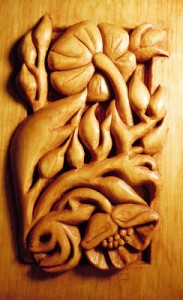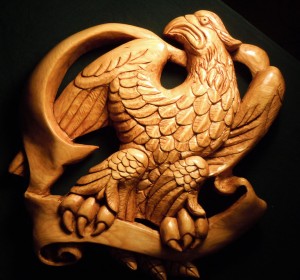Some woods are very absorbent. Basswood is one of those woods. Because of its absorbency, it should be sealed before staining. If you don’t seal it, don’t be surprised if some parts of the carving absorb more stain than other parts, resulting in a blotchy appearance.

After sealing my carving with thinned polyurethane varnish, a light-colored gel stain was applied.
In Why Seal Wood Before Staining I recommend shellac as a sealer. You have other alternatives to shellac. You could use a wood conditioner, such as Minwax® Pre-Stain Wood Conditioner. Be aware that wood conditioners are not the same thing as a sanding sealers. Only use a sanding sealer if you are not staining the wood but just coating the substrate with a clean finish, such as varnish.
Another option is to seal the wood with thinned polyurethane varnish. I have recently used this mixture on two carvings with great success. Here’s what I did.
- After sanding, wipe the wood clean of any dust with a lint-free rag dampened with mineral spirits or a tack cloth.
- Prepare a 50:50 mixture of polyurethane varnish and mineral spirits.
- Using a paint brush, coat the surface of the carvings with the thinned varnish. If the wood is thirsty, it will drink up plenty of the mixture.
- Allow 24 to 48 hours for the thinned varnish to dry. If there is any dried contaminate on the surface of the wood, buff the surface with 0000 steel wool to remove the debris. After this procedure, wipe the surface clean with a tack rag.
- Apply a second coating of the thinned varnish mixture to the carving. Again, I used a 50:50 mixture.
- After allowing 24 to 48 hours for the thinned varnish to thoroughly dry, I stained the carvings with gel stain.
- The finishing touch was to apply two coats of polyurethane varnish.

The eagle carving was sealed, stained and then coated with polyurethane varnish.


